If you've ever driven a car with a persistent check engine light that just won't quit, imagine how frustrating it would be if your John Deere 5045E had a similar issue. Engine overheating is just one of the common problems that can put a damper on your workday. But fret not, as we shed light on other potential pitfalls that might await you with this tractor model. Stay tuned to discover practical tips on troubleshooting and preventing these issues to keep your John Deere 5045E running smoothly and efficiently.
Things to Note
- Engine overheating due to low coolant levels or radiator blockages.
- Hydraulic leaks from worn hoses, fittings, or connections.
- Electrical failures like loose connections or damaged wiring harness.
- Transmission issues from low fluid levels or worn clutch components.
- Fuel system challenges such as clogged filters or contaminated fuel.
Engine Overheating
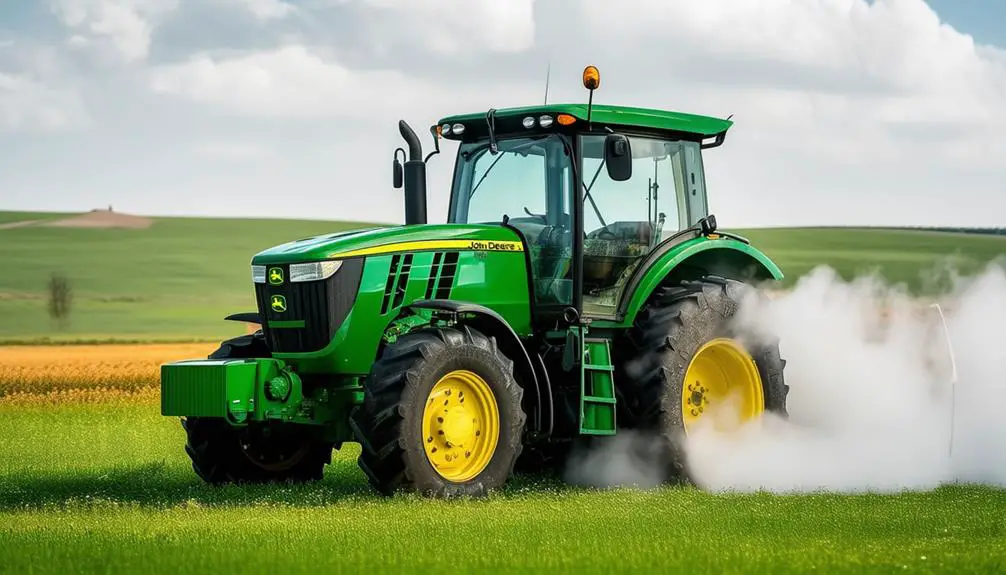
If your John Deere 5045E is experiencing engine overheating issues, check the coolant levels and radiator for any blockages. Insufficient coolant or a clogged radiator can hinder the engine's ability to regulate temperature, leading to overheating.
Start by making sure the coolant reservoir is filled to the recommended level, and there are no leaks in the system. If coolant levels are satisfactory, inspect the radiator for debris or foreign objects that may be blocking airflow. Clear any obstructions carefully to allow proper cooling.
Another potential cause of engine overheating could be a malfunctioning thermostat. A faulty thermostat may not open at the correct temperature, preventing coolant from circulating effectively. Consider having a professional inspect and replace the thermostat if necessary. Additionally, check the radiator cap for a proper seal to maintain the system's pressure.
Regular maintenance and monitoring of coolant levels and the radiator are essential to prevent engine overheating and ensure peak performance of your John Deere 5045E.
Hydraulic System Leaks
Inspect hydraulic system leaks on your John Deere 5045E by examining hoses, connections, and fittings for any indications of oil seepage or dripping. Hydraulic system leaks can result in reduced performance and potential damage if not dealt with. Freeing yourself from these issues involves proactive maintenance.
Regularly examine the hydraulic hoses for cracks, wear, or loose connections. Verify that all fittings are securely tightened to prevent leaks. If you observe any oil seepage, address it promptly to avoid further complications. Leaks can occur due to worn-out seals, damaged hoses, or loose connections.
Electrical System Failures
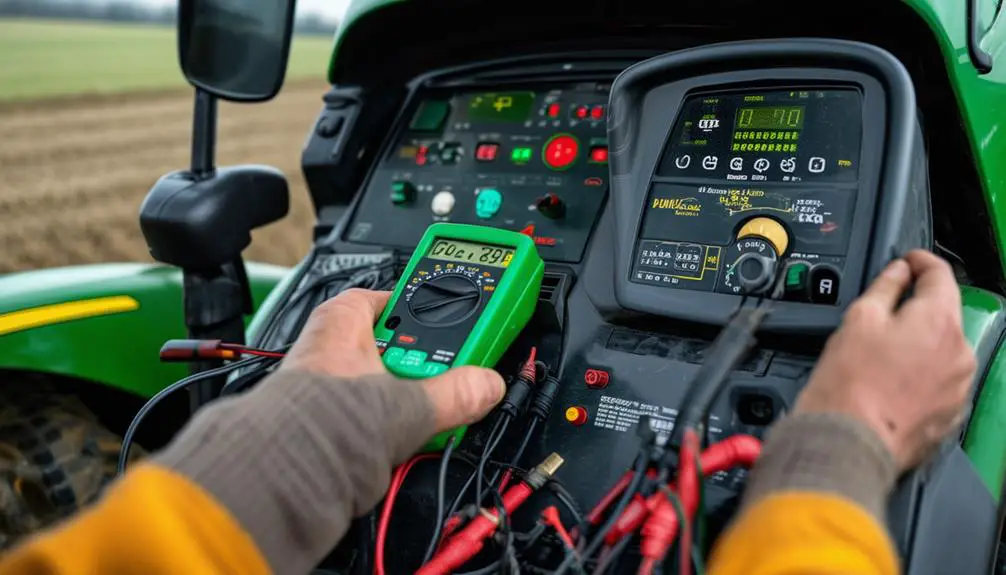
Examine the electrical system of your John Deere 5045E regularly to prevent potential failures and maximize performance. Electrical system failures can be frustrating and costly to repair, but with a proactive approach, you can avoid many common issues.
Here are some tips to help you keep your tractor running smoothly:
- Check the Battery Connections: Loose or corroded battery connections can cause electrical problems. Make certain the connections are clean, tight, and free of any corrosion.
- Inspect the Wiring Harness: Look for any signs of wear, fraying, or damage to the wiring harness. Damaged wires can lead to shorts or malfunctions in the electrical system.
- Monitor the Fuses: Periodically check the fuses in your John Deere 5045E to make sure they aren't blown. Faulty fuses can disrupt the electrical flow and cause systems to fail.
Regular maintenance of these components can help prevent unexpected electrical failures and keep your tractor operating smoothly.
Transmission Issues
You may encounter gear shifting problems and clutch slippage concerns with your John Deere 5045E.
These transmission issues can lead to difficulties in changing gears smoothly and may affect the overall performance of your tractor.
Addressing these issues promptly is crucial to prevent further damage and maintain peak functioning.
Gear Shifting Problems
Experiencing difficulties with gear shifting on your John Deere 5045E can be indicative of underlying transmission issues. When facing gear shifting problems, it's important to address them promptly to prevent further damage and keep your machine running smoothly.
Here are a few things to keep in mind:
- Low Transmission Fluid Levels: Check the transmission fluid levels as low fluid can impede proper gear shifting, leading to rough adjustments.
- Worn Out Clutch Components: Over time, clutch components can wear out, causing gear shifting issues. Regular maintenance can help prevent this.
- Misaligned Gear Shift Linkage: A misaligned gear shift linkage can result in challenges when trying to change gears. Ensuring the linkage is properly aligned can make a significant difference in gear shifting performance.
Clutch Slippage Concerns
If you observe your John Deere 5045E showing clutch slippage, it could indicate underlying transmission issues that demand attention. Clutch slippage occurs when the engine revs up without a corresponding increase in tractor speed, making your work less efficient and potentially causing damage over time.
This problem may arise from worn-out clutch facings, improper clutch adjustments, or low clutch fluid levels.
To address clutch slippage concerns, begin by checking the clutch adjustment to verify it meets the manufacturer's specifications. Next, inspect the clutch facings for signs of wear and tear. If worn, replacing them can restore proper clutch functionality. Additionally, assess the clutch fluid levels and top up if necessary.
Neglecting clutch slippage can lead to further transmission damage and more costly repairs down the line. By promptly addressing these issues, you can maintain the performance and longevity of your John Deere 5045E, guaranteeing smooth operations in the field.
PTO Problems
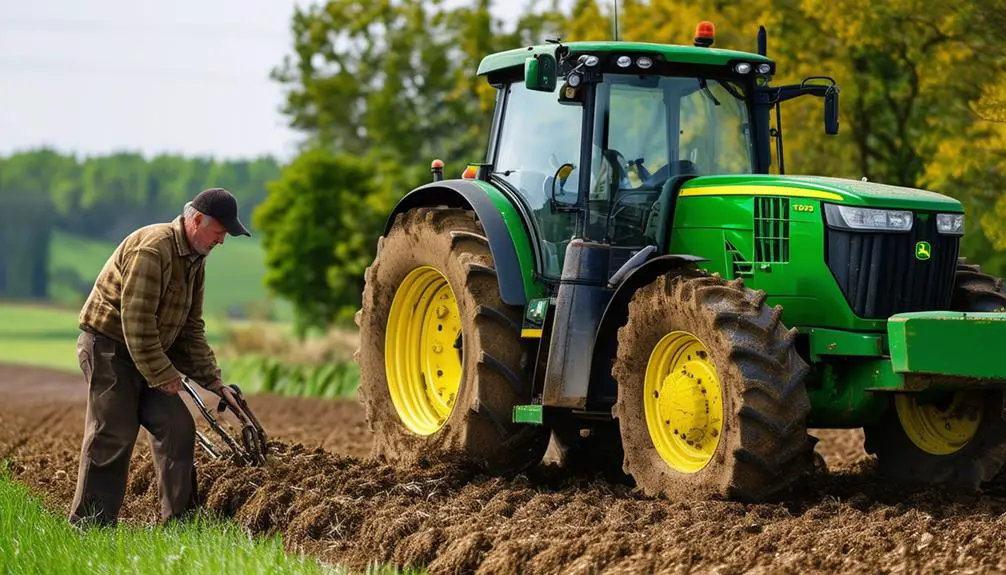
If you're facing PTO problems with your John Deere 5045E, you might encounter issues like the PTO not engaging when needed, slipping under load, or unexpectedly disengaging during operation.
These problems can impact the efficiency and productivity of your tractor, necessitating timely attention and potential repairs to guarantee smooth functioning.
Regular maintenance and inspections can help prevent PTO issues and keep your equipment running smoothly.
PTO Not Engaging
Having trouble with your PTO not engaging on your John Deere 5045E? When your power take-off isn't working as it should, it can be frustrating and hinder your productivity. Here are a few things to check to help you get back to work swiftly:
- Check PTO Engagement Lever: Confirm that the PTO engagement lever is fully engaged. Sometimes it may appear to be engaged but could be slightly off, causing the PTO not to function correctly.
- Inspect for Debris or Damage: Look for any debris or damage around the PTO connection points. Sometimes dirt, debris, or damage can prevent the PTO from engaging properly.
- Verify Hydraulic Fluid Levels: Low hydraulic fluid levels can also lead to PTO engagement issues. Check the hydraulic fluid levels and top up if necessary to ensure smooth PTO operation.
PTO Slipping Issues
To address PTO slipping issues on your John Deere 5045E, inspect the PTO clutch for signs of wear or misalignment. A slipping PTO can hinder your work and lead to frustration.
Begin by checking for any visible damage or wear on the PTO clutch components. Look for worn-out or broken parts that may be causing the slipping problem. Additionally, verify that the PTO clutch is properly aligned. Misalignment can result in inefficient power transfer, causing the PTO to slip during operation. Tighten any loose bolts or connections that could be contributing to the issue.
If you notice any issues during your inspection, consider replacing damaged parts or realigning the clutch to resolve the slipping problem. Regular maintenance and inspection of the PTO clutch can prevent slipping and guarantee smooth operation of your John Deere 5045E.
PTO Disengaging Unexpectedly
One common issue experienced with the John Deere 5045E is the PTO disengaging unexpectedly. This problem can be frustrating when you're in the middle of your work and the PTO stops without warning.
To address this issue effectively and get back to work swiftly, consider the following tips:
- Check PTO Connections: Verify all PTO connections are secure and free from any debris or damage that could be causing the disengagement.
- Inspect PTO Switch: Sometimes, a faulty PTO switch can lead to unexpected disengagement. Examine the switch for any signs of wear or malfunction.
- Examine PTO Clutch: The PTO clutch may be worn out or in need of adjustment, leading to disengagement problems. Have a technician inspect and adjust the clutch if necessary.
Steering Troubles
Experiencing difficulty in steering is a common issue reported by John Deere 5045E owners. When your steering system isn't working smoothly, it can hinder your efficiency and make tasks more challenging than they need to be.
The most frequent problem encountered is steering that feels stiff or unresponsive, requiring more effort from you to maneuver the tractor effectively.
If you notice erratic steering behavior, such as the wheels pulling to one side unexpectedly or the steering wheel vibrating excessively, it's essential to address these issues promptly. Ignoring these signs can lead to more severe problems down the line and potentially compromise your safety while operating the tractor.
To tackle steering troubles head-on, start by checking the power steering fluid levels and ensuring there are no visible leaks. Additionally, inspect the steering linkage and components for any signs of wear or damage that may be causing the issues.
Fuel System Malfunctions
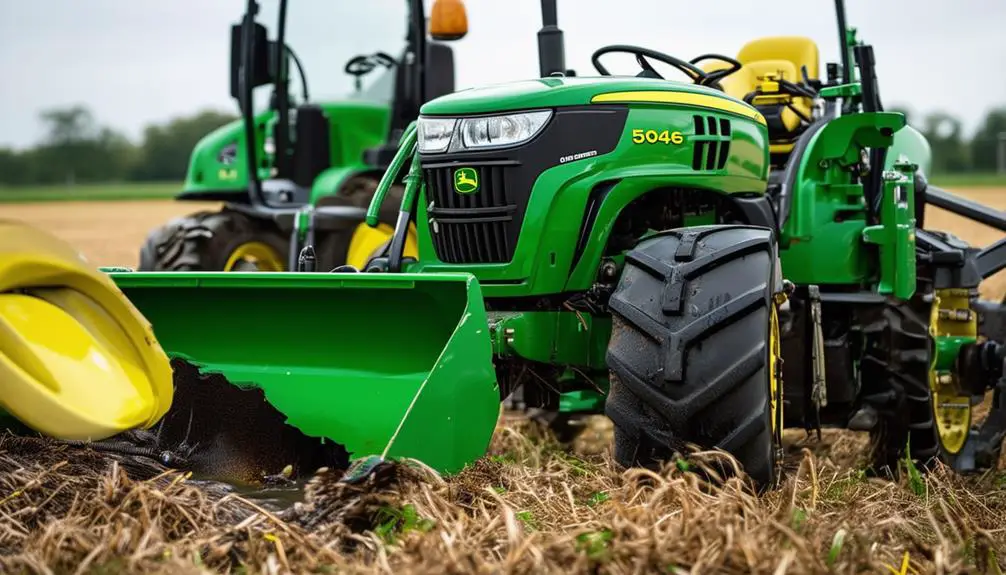
If you notice your John Deere 5045E experiencing fuel system malfunctions, addressing them promptly is essential to achieve the best performance of your tractor.
Here are some common issues you might encounter:
- Clogged Fuel Filters: Over time, dirt and debris can clog the fuel filters, restricting the flow of fuel to the engine. Regularly check and replace your fuel filters to prevent this issue.
- Fuel Contamination: Water or other contaminants can find their way into the fuel system, causing disruptions in engine performance. Be cautious when refueling to avoid introducing impurities into the system.
- Faulty Fuel Pump: A malfunctioning fuel pump can lead to inadequate fuel delivery to the engine, resulting in poor performance or stalling. If you notice irregularities in engine power, have the fuel pump inspected and replaced if necessary.
Cooling System Failures
Common issues with the John Deere 5045E may arise due to cooling system failures. When the cooling system malfunctions, it can lead to overheating, which in turn can cause serious damage to the engine if not addressed promptly. Here are some common cooling system failures that you might encounter with your John Deere 5045E:
| Cooling System Failure | Symptoms |
|---|---|
| Leaking Radiator | Engine overheating |
| Faulty Thermostat | Temperature gauge fluctuations |
| Water Pump Issues | Coolant leaks |
If you notice any of these symptoms, it's essential to address them immediately to prevent further damage to your tractor. Regularly checking the cooling system components for leaks, proper functioning of the thermostat, and the overall coolant level can help you catch potential issues early on. By staying proactive and attentive to your John Deere 5045E's cooling system, you can ensure its longevity and peak performance.
Clutch Slippage
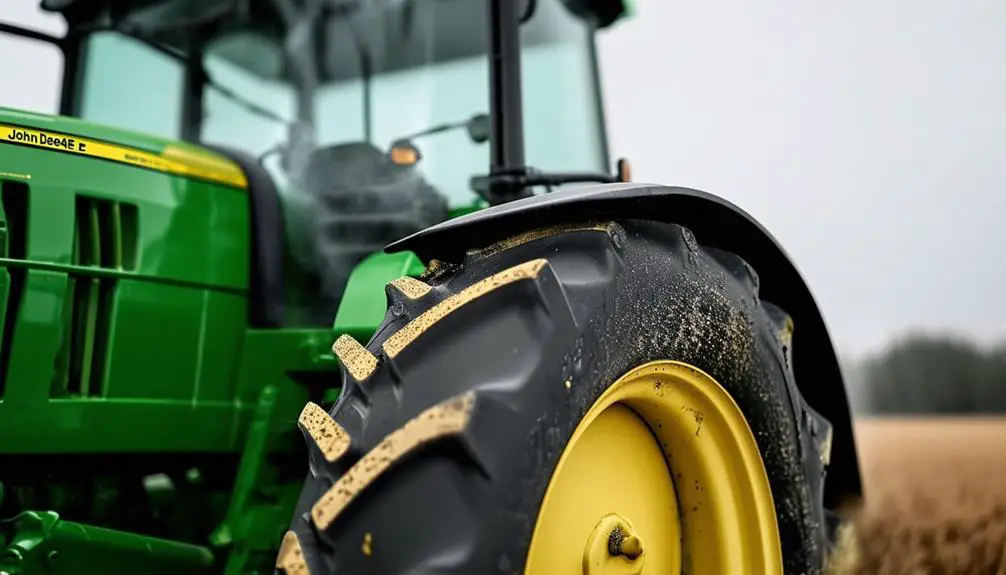
Address clutch slippage promptly to prevent potential damage to your John Deere 5045E tractor. When you notice the clutch slipping, it's essential to take action to make sure the continued smooth operation of your tractor.
Here are some steps you can take to tackle this issue effectively:
- Check Clutch Adjustment: Start by checking the clutch adjustment to make sure it's within the manufacturer's specifications. Incorrect clutch adjustment can lead to slippage and reduced efficiency.
- Inspect Clutch Components: Inspect the clutch components for wear and tear, such as the clutch disc, pressure plate, and release bearing. Worn-out components can cause the clutch to slip and should be replaced promptly.
- Examine Hydraulic System: Make sure to examine the hydraulic system responsible for clutch operation. Low hydraulic fluid levels or leaks can result in insufficient pressure, leading to clutch slippage.
Frequently Asked Questions
How Can I Prevent Common John Deere 5045E Problems?
To prevent common John Deere 5045E problems, you should follow regular maintenance schedules. Stay on top of servicing tasks like changing oil, filters, and inspecting components.
Operate the tractor within recommended limits and avoid overloading. Keep an eye out for any signs of wear or damage and address them promptly.
Proper storage and cleanliness also play a key role in preventing issues. Routine care can help you avoid many common problems.
Are There Any Recommended Maintenance Schedules for This Model?
To keep your John Deere 5045E running smoothly, sticking to the recommended maintenance schedule is crucial. Regular maintenance is like a compass guiding you on a journey free of unexpected breakdowns.
By following the maintenance guidelines outlined in the manual, you can guarantee your tractor operates at its peak and avoid costly repairs down the road.
Stay proactive and enjoy worry-free farming with proper maintenance routines.
What Are the Warranty Options Available for This Tractor?
You've got a few warranty options available for your tractor. John Deere typically offers different coverage plans like powertrain, inclusive, or extended warranties.
These plans can help protect your investment and give you peace of mind in case anything goes wrong with your machine.
Make sure to check with your local dealer to see what specific warranty options are available for your John Deere 5045E.
Can Aftermarket Parts Be Used to Fix These Issues?
You can definitely use aftermarket parts to fix the issues with your tractor. They offer a cost-effective solution and a wider range of options to choose from.
Before making any changes, confirm compatibility with your John Deere 5045E. Aftermarket parts can be a practical choice for enhancing performance or replacing worn-out components.
Remember to check reviews and verify quality to guarantee a successful repair.
Is There a Troubleshooting Guide for DIY Repairs?
If you're looking to tackle DIY repairs on your equipment, having a troubleshooting guide can be a game-changer. It helps you pinpoint issues efficiently and work towards fixing them yourself.
With the right guide, you can save time and money by avoiding unnecessary trips to the repair shop. It empowers you to take control of your repairs and get your equipment up and running again in no time.
Conclusion
To sum up, keeping an eye on your John Deere 5045E for common issues like engine overheating, hydraulic leaks, and electrical failures is key to ensuring its longevity.
Don't let these problems steer you off course – stay ahead of the game with regular maintenance and prompt repairs.
Remember, a well-maintained tractor is like a smooth sailing ship in the vast sea of farming challenges.